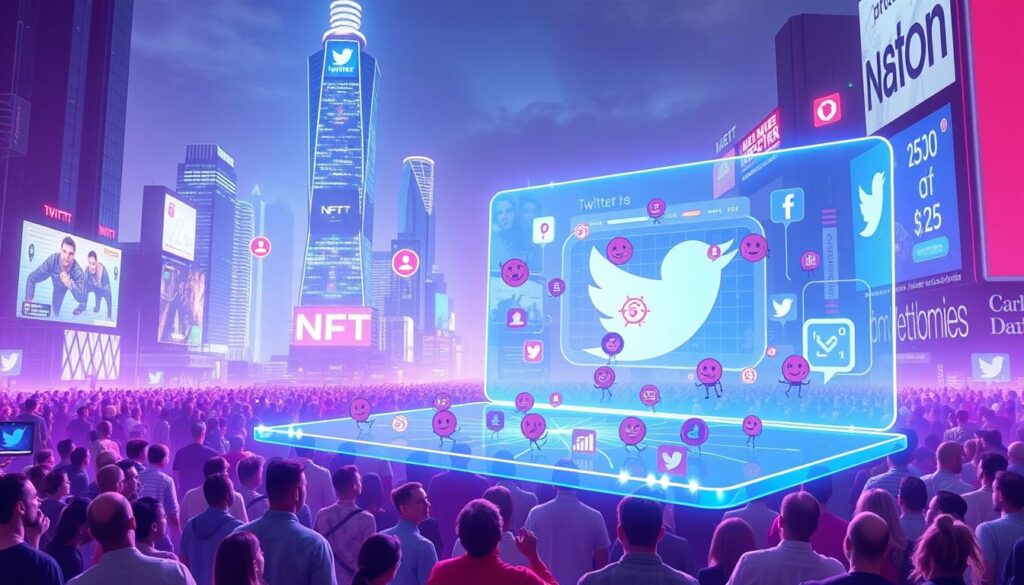Now Reading: NFT Utility Tokens: Unlocking Digital Asset Potential
- 01
NFT Utility Tokens: Unlocking Digital Asset Potential
NFT Utility Tokens: Unlocking Digital Asset Potential
The digital economy is evolving rapidly, moving beyond static collectibles to dynamic tools with real-world applications. At the forefront of this shift are blockchain-based assets designed for specific functions within ecosystems. These innovations blend ownership rights with practical benefits, creating new opportunities across industries.

Unlike traditional digital art formats, purpose-driven assets offer tangible value through access privileges or platform features. Gaming studios now reward loyal players with special perks, while musicians use them to distribute exclusive content. This approach transforms how creators engage audiences and monetize work.
Market trends show growing demand for assets that deliver ongoing advantages rather than speculative value. Brands leverage these tools to build communities and foster loyalty through shared ownership models. The technology also addresses environmental concerns with energy-efficient blockchain solutions.
Key Takeaways
- Functional digital assets provide practical benefits beyond basic ownership
- Industries like gaming and entertainment lead adoption through creative use cases
- Energy-efficient blockchain methods reduce environmental impact concerns
- Shared ownership models strengthen creator-fan relationships
- Regulatory clarity continues evolving alongside market innovation
Understanding NFT Utility Tokens and Their Impact on Digital Assets
Modern digital ownership models are shifting focus from decorative items to purpose-driven tools. These blockchain-based innovations combine provable ownership with practical advantages, creating new opportunities for creators and users alike.

What Are Functional Blockchain Assets?
These specialized digital items provide real-world advantages beyond basic collectibility. Unlike standard digital art files, they might unlock game features, private communities, or educational materials. A music artist could offer backstage passes through them, while a learning platform might provide course certificates.
Key Differences from Standard Digital Collectibles
Traditional versions primarily serve as status symbols or investment vehicles. Functional alternatives deliver:
- Ongoing access to premium content
- Voting rights in community decisions
- Physical/digital item redemption options
Their value comes from practical use rather than scarcity alone. This approach helps creators build lasting relationships through shared benefits. For deeper insights, explore our guide on functional blockchain assets and their evolving roles.
How NFT Utility Tokens Work on Blockchain Technology
Blockchain mechanics power next-generation ownership models that blend digital authenticity with real-world benefits. These systems enable creators to design interactive experiences while maintaining secure ownership records.

The Creation Process
Each digital asset begins its journey through minting – a verification process where unique identifiers get embedded in blockchain records. This digital fingerprint ensures authenticity while preventing counterfeits. Ownership history becomes permanently visible through decentralized ledgers.
Automated Access Controls
Programmable contracts execute specific actions when conditions get met. Artists might automatically grant exclusive content access to holders, while brands could trigger loyalty rewards. These self-operating systems remove middlemen while ensuring fair benefit distribution.
Blending Digital and Physical
Advanced systems connect blockchain ownership to tangible experiences through:
- QR code verification for event entry
- Digital twins of physical merchandise
- Cross-platform membership privileges
Developers achieve this through interoperability standards, letting assets function across multiple ecosystems. For example, blockchain-based access passes might unlock both virtual meetups and real-world product discounts.
This technical foundation enables creators to design layered experiences that evolve with community needs. From voting mechanisms to time-sensitive rewards, the possibilities grow as blockchain adoption expands.
Diverse Use Cases and Real-World Benefits of Utility NFTs
Digital collectibles are evolving into multi-purpose tools across industries, delivering practical advantages that extend far beyond simple ownership. These blockchain-based innovations reshape how users interact with content, communities, and virtual environments.
In-Game Assets and Virtual Real Estate
Gaming platforms lead adoption by transforming virtual items into tradable assets. Players in titles like World of Freight collect customizable racing machines, while metaverse worlds like Decentraland enable land development. Owners monetize digital properties through:
- Virtual storefronts for branded merchandise
- Interactive experiences for community engagement
- Rental systems for event hosting
Memberships, Event Tickets, and Exclusive Access
Blockchain-based passes revolutionize access management. Sports teams issue digital tickets that unlock behind-the-scenes content, while brands use them for VIP loyalty programs. Holders might gain:
- Early product release privileges
- Exclusive meet-and-greet opportunities
- Voting rights in community decisions
Platforms now enable users to earn rewards through blockchain-based memberships, blending digital access with real-world perks. This approach creates lasting value by connecting ownership to evolving experiences.
NFT Utility Tokens: Exploring Use Cases Across Industries
Blockchain-based ownership models are merging digital collectibility with interactive experiences. These systems empower users through tangible benefits that evolve beyond initial acquisition. Let’s examine two sectors driving adoption through creative implementations.

Enhancing the Gaming Experience
Modern games now let players truly own their achievements. Rare weapons or character skins become transferable assets across platforms. This shift creates new economic models where skilled gamers earn rewards through:
- Cross-game item compatibility
- Marketplace trading systems
- Skill-based competitions
Popular titles allow communities to co-create content using owned assets. A sword earned in one game might unlock special abilities in another. This interoperability increases item value while deepening player engagement.
Revolutionizing Memberships and Access
Brands are reimagining loyalty programs through blockchain technology. A restaurant chain might offer digital passes granting:
- Priority reservations
- Secret menu access
- Chef-led cooking classes
These systems automatically update benefits based on participation levels. Music festivals use similar models for backstage upgrades, creating lasting connections between artists and fans. The approach ensures exclusive perks remain dynamic rather than static.
Successful NFT Utility Projects and Industry Examples
Forward-thinking initiatives demonstrate how blockchain assets create lasting value through creative applications. These case studies reveal diverse approaches to blending digital ownership with real-world engagement.
Community-Driven Golf Innovation
LinksDAO reimagines country clubs through decentralized governance. Members gain voting rights on course acquisitions and event planning while accessing exclusive tournaments. This model proves how shared decision-making strengthens brand loyalty in niche markets.
Event Access Redefined
Gary Vaynerchuk’s VeeFriends series offers conference tickets and mentorship opportunities. Holders receive annual access to VeeCon, creating recurring value beyond initial purchases. The project highlights how consistent benefits maintain long-term interest.
Governance Through Collective Action
The Doodles collection empowers owners to steer creative direction through proposals. A community treasury funds new initiatives voted on by holders. This system shows how decentralized control can drive project evolution while maintaining artistic vision.
Sportswear giant Nike partnered with RTFKT to merge physical products with digital twins. Their CloneX avatars unlock limited-edition sneakers, blending augmented reality with wearable tech. This approach demonstrates cross-industry potential for loyalty program innovation through hybrid experiences.
These examples share key success factors: clear member benefits, ongoing engagement opportunities, and adaptable reward structures. They prove digital ownership models thrive when prioritizing practical applications over speculative value.
Implementing Practical Utility in Your NFT Projects
Successful blockchain initiatives thrive when creators focus on solving real needs rather than speculative hype. The most engaging projects combine ownership with interactive elements that keep communities invested long-term.
Strategies for Adding Value and Functionality
Start by identifying gaps in your audience’s experience. Gaming platforms reward active players with rare skins that unlock special abilities. Music artists might offer ticket upgrades granting meet-and-greet access. Consider these approaches:
Time-sensitive benefits create urgency – think limited merch drops or voting periods. Tiered membership systems let users unlock rewards through participation levels. Always align perks with your community’s core interests.
Integrating Digital and Physical Experiences
Blend blockchain advantages with real-world touchpoints. Concert passes could include AR filters activated at venues. Restaurant loyalty programs might pair digital collectibles with chef-curated dining events.
Use QR codes to verify ownership for exclusive access. Fashion brands successfully merge physical products with digital twins, letting owners showcase items in virtual spaces. This hybrid model strengthens emotional connections across platforms.
By prioritizing practical applications over empty promises, creators build sustainable ecosystems. The key lies in designing benefits that evolve with user engagement – turning temporary excitement into lasting value.
FAQ
What defines a utility token in the context of digital collectibles?
These tokens embed practical benefits like exclusive access, voting rights, or rewards within their blockchain framework. Unlike standard collectibles, they prioritize functionality over mere ownership, often linking to real-world perks or interactive experiences.
How do utility-focused digital collectibles differ from traditional ones?
Traditional versions primarily serve as ownership proofs for art or media. Utility-driven versions add layers like event passes, gaming perks, or community governance. For example, owning a Bored Ape Yacht Club collectible unlocks member-only events and merchandise.
What role do smart contracts play in granting access to perks?
Smart contracts automate access control through token gating. Platforms like Shopify or Discord verify ownership via blockchain, letting holders enter private groups, redeem concert tickets, or claim limited-edition physical goods tied to their digital assets.
Can these tokens bridge virtual and physical experiences?
Yes. Projects like RTFKT merge both worlds by offering augmented reality wearables or limited sneaker drops. VeeFriends uses them for conference passes, while LinksDAO provides golf course bookings, blending online ownership with offline benefits.
How are industries like gaming adopting utility-driven models?
Games like Axie Infinity let players earn tradable in-game items, while Decentraland parcels act as virtual real estate. These assets grant revenue-sharing opportunities or creative control, transforming passive ownership into active participation.
What strategies ensure long-term value for utility-focused projects?
Successful examples like Doodles use tiered access and community voting. Brands should prioritize scarcity, recurring perks (e.g., annual events), and partnerships—like exclusive Spotify playlists for holders—to sustain engagement beyond initial sales.












